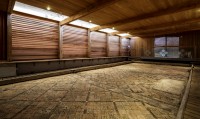 An extremely rare surviving 13th century tile floor at Cleeve Abbey in Somerset is now back on display under a new, state-of-the-art shelter. The oak shelter will protect the 40 x 16-foot section of pavement from the elements, something its predecessor, a tent, could not do.
An extremely rare surviving 13th century tile floor at Cleeve Abbey in Somerset is now back on display under a new, state-of-the-art shelter. The oak shelter will protect the 40 x 16-foot section of pavement from the elements, something its predecessor, a tent, could not do.
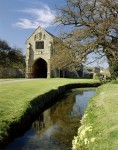 Cleeve Abbey was a Cistercian monastery founded by William de Roumare, Earl of Lincoln, in 1198. Populated by only 12 monks in the beginning, by the mid-13th century there was a cruciform church, a cloister, chapter house, sacristy and dormitory. The refectory was constructed in the second half of the 1200s, probably around 1270, and it was paved with expensive polychrome encaustic tiles nine inches square. Each tile is decorated with heraldic designs. The arms of several aristocratic benefactors of the monastery were kiln-baked into the floor tiles, including the chevrons of the earls of Gloucester from the de Clare family, the lion rampant
Cleeve Abbey was a Cistercian monastery founded by William de Roumare, Earl of Lincoln, in 1198. Populated by only 12 monks in the beginning, by the mid-13th century there was a cruciform church, a cloister, chapter house, sacristy and dormitory. The refectory was constructed in the second half of the 1200s, probably around 1270, and it was paved with expensive polychrome encaustic tiles nine inches square. Each tile is decorated with heraldic designs. The arms of several aristocratic benefactors of the monastery were kiln-baked into the floor tiles, including the chevrons of the earls of Gloucester from the de Clare family, the lion rampant  of the earls of Cornwall, the double-headed eagle of Richard of Cornwall, second son of King John of Magna Carta fame, who bribed his way into election as King of the Romans (ie, King of what would become Germany) in 1257, and the three white lions of the Royal Coat of Arms representing monastery patron King Henry III, Richard’s brother. Archaeologists believe they were manufactured by a tilery in Gloucestershire and installed to celebrate the marriage of Edmund, 2nd Earl of Cornwall, to Margaret de Clare in 1272.
of the earls of Cornwall, the double-headed eagle of Richard of Cornwall, second son of King John of Magna Carta fame, who bribed his way into election as King of the Romans (ie, King of what would become Germany) in 1257, and the three white lions of the Royal Coat of Arms representing monastery patron King Henry III, Richard’s brother. Archaeologists believe they were manufactured by a tilery in Gloucestershire and installed to celebrate the marriage of Edmund, 2nd Earl of Cornwall, to Margaret de Clare in 1272.
In the 15th century, the old refectory was demolished and a new, larger refectory was built just to its north. The old tile floor was not reused elsewhere (the usual practice when dealing with luxurious features like these tiles), but buried, keeping it in situ in its original configuration virtually undamaged for 400 years. Thanks to its hiding place, the floor made it through the Dissolution of the Monasteries unscathed while the abbey church was demolished. Henry VIII sold the abbey property and other structures, stripping any valuable architectural features for individual sale. The abbey became a farm, and most of the buildings are still standing today because of it.
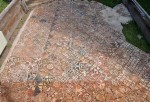 The Cleeve Abbey tiled pavement is the only large example of a decorated medieval refectory floor in Britain. The fact that it survived with its original placement still intact makes it a rarity of international significance. A smaller piece of the 13th century church floor was also discovered at Cleeve Abbey, and while it too is made of colorful encaustic tiles, they have been relain and look like a patchwork quilt now.
The Cleeve Abbey tiled pavement is the only large example of a decorated medieval refectory floor in Britain. The fact that it survived with its original placement still intact makes it a rarity of international significance. A smaller piece of the 13th century church floor was also discovered at Cleeve Abbey, and while it too is made of colorful encaustic tiles, they have been relain and look like a patchwork quilt now.
The old refectory floor was rediscovered in 1876. To protect it for future generations, the floor was reburied until 1951 when it was again exposed and displayed to the public. It was covered each winter to save it from inclement weather and uncovered during the summer months so tourists could view it.
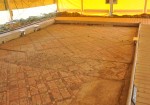 In the 1990s, tests by English Heritage found that the tiles were dangerous deteriorating from their exposure to the elements. Thermal stress was damaging the protective glaze surface and eroding the detailed patterns in the clay, while microbes and high salt gnawed away the priceless pavement. In an attempt to prevent further damage, English Heritage installed a marquee tent over the floor tiles, which helped keep the sun’s rays from hitting the tiles directly but was only a temporary solution while they worked on a permanent one.
In the 1990s, tests by English Heritage found that the tiles were dangerous deteriorating from their exposure to the elements. Thermal stress was damaging the protective glaze surface and eroding the detailed patterns in the clay, while microbes and high salt gnawed away the priceless pavement. In an attempt to prevent further damage, English Heritage installed a marquee tent over the floor tiles, which helped keep the sun’s rays from hitting the tiles directly but was only a temporary solution while they worked on a permanent one.
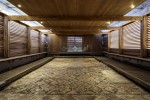 Last year construction began on a new shelter made of louvred oak slats which allow light to enter the space for optimal viewing, but keep direct sunlight from beating down on the tiles. There’s a ventilation system which keeps the temperatures inside the enclosure stable at all times. Visitors can enjoy the floor comfortably from seating and viewing platforms.
Last year construction began on a new shelter made of louvred oak slats which allow light to enter the space for optimal viewing, but keep direct sunlight from beating down on the tiles. There’s a ventilation system which keeps the temperatures inside the enclosure stable at all times. Visitors can enjoy the floor comfortably from seating and viewing platforms.
The new shelter opened on Good Friday, March 25th, 2016, and will be open daily through October 21st, 2016, which is when Cleeve Abbey closes for the winter. It will open again next spring.
Fabulous discovery. I love Medieval tiles. Thanks for sharing.
I remember being amazed at the beautiful tiles exposed to the elements at Rievaulx Abbey (North Yorkshire). This was early ’70s.
That’s a gorgeous floor!
Karlsdottir, I saw the tiles at Rievaulx in 2005. They were still amazing and still out in the open.
“I am just a sherd in the Lord’s Medieval rearranged tiled floor”
:love:
Good to know!
The next time I read a blog, I hope that it doesnt disappoint me as much as this one. I mean, I know it was my choice to read, but I actually thought youd have something interesting to say. All I hear is a bunch of whining about something that you could fix if you werent too busy looking for attention.